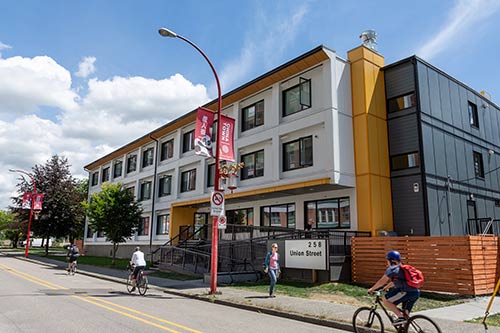Insight: REIBC blog > Supportive Housing and a Social Return on Investment
 |
Nora Hendrix Place in Vancouver. Credit: BC Housing
|
Nora Hendrix Place is a dedicated-site supportive housing project newly opened on Union Street in Vancouver’s Strathcona neighbourhood. Initiated under BC Housing’s Rapid Response to Homelessness program, the project is located in what was once known as Hogan’s Alley and home to Vancouver’s Black community. Nora Hendrix Place provides 52 supportive homes that prioritize Black and Indigenous residents, who are overrepresented in Vancouver’s homeless population. BC Housing, the City of Vancouver, PHS Community Services Society, and Hogan’s Alley Society were partners in the project.
Supportive housing projects, like Nora Hendrix Place and many others, aren’t always looked upon favourably by their neighbours. “Despite the significant and ongoing success of many of these supportive housing projects, some people still object to supportive housing being located in their communities, fearing that it will decrease property values or increase criminal activity,” says Shayne Ramsay, CEO of BC Housing. “In fact, our experience supports that there is a wide range of benefit to a variety of different stakeholder groups in the community, in both the short and long terms.”
Are social returns quantifiable? BC Housing says they are, pointing to its study, The Social and Economic Value of Dedicated-Site Supportive Housing in BC, which looked at the kind of housing that Nora Hendrix Place exemplifies.
“The most significant and tangible benefits are those experienced by the people who will be living in the housing, including housing stability, increases in personal wellbeing, healthier living conditions, ability to participate in employment, reduced substance use, and increased safety and social connections,” explains Ramsay. “In addition, there are social and economic benefits to the community, including increased revenue from permits and taxes, increased local spending and employment, decreased use of emergency and social services, and reduced homelessness.”
For dedicated-site projects, the research showed that for every dollar invested, an estimated four or five dollars in social and economic value is created.
 |
| Download Summer 2019 |
Read more about BC Housing’s approach to housing, partnerships, and social returns in Ramsay’s “Partnerships Are Key to Building Healthy Communities” in the Summer 2019 edition of Input. Download Summer 2019
Join the conversation on Facebook
